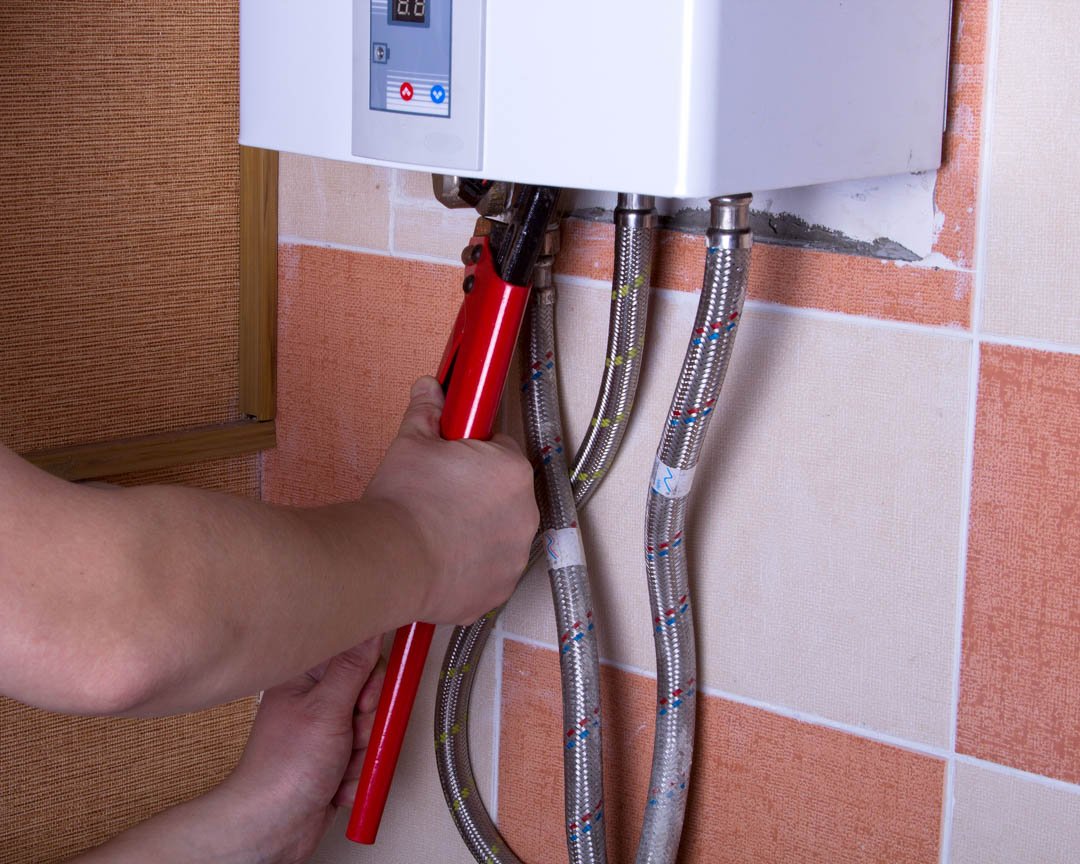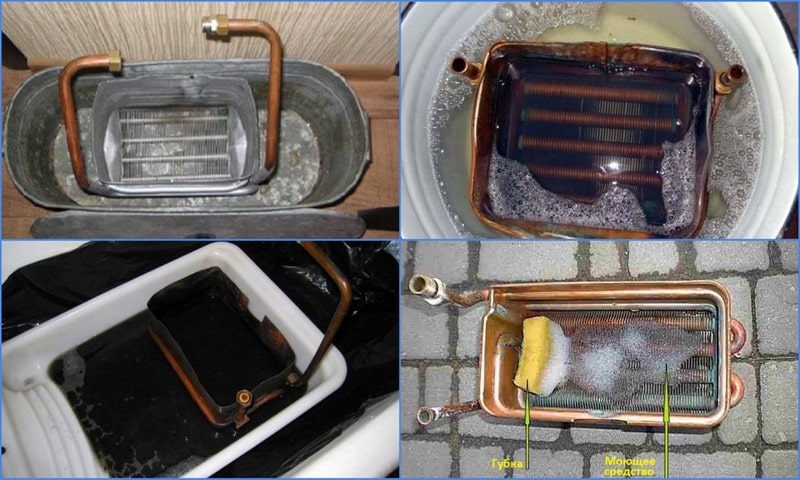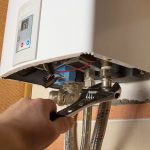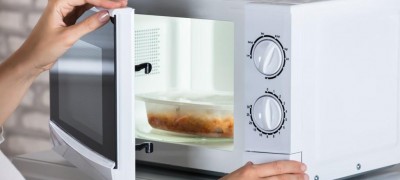How and how to clean a gas water heater - step by step instructions
Many people prefer gas water heaters to electric boilers. Their main task is to heat water for domestic purposes. The frequency of use of the equipment, the type of its operation, become the causes of blockage. The result is the failure of the device, the need to carry out repairs. What is cleaning a gas water heater, what skills and tools will be needed for this, and much more further in the article.

Causes of contamination of gas columns
Considering the principle of operation of the column, one can understand why blockages and contamination appear. Water heating is carried out using gas combustion, which implies the formation of soot and carbon deposits.

Consider what breakdowns are most common:
- Wick. Even here, a lot of soot is formed, which prevents the normal operation of the device.
- Water heater pipes. This is where one of the biggest problems can happen - a blockage in the form of scale deposited on the walls of the pipes. This problem will not be solved by itself, it will only grow and worsen, gradually blocking the pipe completely.
- Heat exchanger. Another active element, represented by a group of tubes with an outlet above the column. Due to the accumulation of limescale, the function of the heat exchanger may be impaired.
Above are the main problems that can most often be encountered in practice. But there are also certain signs that will help identify impending trouble and eliminate it in advance.

The main signs of clogging
As a rule, breakdowns make themselves felt quickly enough. Some signs are obvious, others are indirect.

Let's consider the main signals:
- Malfunctions or does not turn on at all. The presence of a stable water pressure and gas supply to the column is a key assessment factor here. If everything is fine, but the column periodically goes out during operation or does not turn on at all, you should pay attention to the incendiary element. Burns can accumulate here, which can only be removed by cleaning.
- Overheating protection activates by itself. To prevent excessive overheating of the column, the device is equipped with a special sensor. It is he who turns off the equipment, gives a signal about a malfunction. In the overwhelming majority of cases, the situation is corrected by cleaning the pipes from scale deposits.
- Decreased productivity. It manifests itself in a decrease in the rate of water heating, a decrease in the pressure of its delivery. The problem may lie in the heat exchanger clogged with scale. Removing deposits on the pipe walls corrects the malfunction.

It is possible and necessary to rinse the gas water heater at home, because blockages are the main reason for its failure. The process is periodic, but mandatory. How and how to do it further.

What are the means for cleaning the gas column
Most manufacturers have taken care of drawing up recommendations for the care of their products, taking into account the specifics of its manufacture and subsequent operation. The same applies to the selection of cleaning agents. Sometimes, with serious problems and difficult contamination, it is better to entrust the cleaning to professionals so that the warranty is preserved. But if you decided to do the work yourself, then the table below will help you figure out what is needed for this.

| Description of the problem | Elimination with folk remedies | Use of chemicals |
| Scale forming inside the pipes | You will need to use a solution of water and citric acid in a ratio of 1: 5, respectively | Calgon or Antinakipin can effectively soften and descale pipes |
| Carbon deposits form on the heat exchanger | A solution of vinegar and heated water in a 1: 3 ratio | Concentrated 7-10% hydrochloric acid (you can use others similar in principle of action) |
Important! Tend to choose the recommended cleaning agents. In case of damage during the work, you need to contact the gas service (104).

Step-by-step cleaning instructions
Depending on the type of pollution (blockage), the chronology of actions is determined and materials, tools, and means are selected. To properly clean the column, you need to take into account the characteristics of its contaminated elements. Everything in order.

Rules for cleaning soot and soot from a heat exchanger
The frequency of cleaning equipment from soot and burning directly depends on the quality of the gas, the frequency of using the device. At home, you can gently remove the soot that has formed on the surfaces of the parts. Disassembling the gas part is recommended only for professionals.

External cleaning is carried out as follows:
- we shut off the gas (valve on the pipe);
- dismantle the upper case;
- using a dry cloth, carefully clean the surface of the internal elements;
- mount the protective case back.

A decrease in the combustion force of the gas wick indicates a clogged nozzle. Finding this element is quite simple - it is located on the gas manifold. A pressure sensor is located nearby. The clogging of the nozzle can be removed with a thin wire. If you are doing the work yourself, be sure to use soapy water, check for gas leaks.

How to remove the heat exchanger and burner
Disassembly may vary depending on the model and type of device. But the principle of action is similar.

So, how to remove the heat exchanger and burner step by step:
- There are control knobs on the front panel. They need to be dismantled.It is not difficult to do this, it is enough to unscrew 2 self-tapping screws (instead of them, plastic clips can serve as a retainer). Then remove the cover.
- Dismantling the smoke box. The wires from the draft sensor will need to be disconnected. And remove the diffuser box held by two screws.
- The heat exchanger tube is disconnected from the water unit (you will need to unscrew the cap washer). The second pipe is released from the lock washer. It is fixed with 2 screws.
- Unscrew 2 screws on the flange, which will make it possible to disconnect the burner from the gas valve. The burner device can be removed by pushing the radiator upwards. Be careful not to damage the parts.
- The back panel is connected to the heat exchanger using self-tapping screws. You need to unscrew them.
- The radiator can be removed completely, like the burner. Disconnect wires with ignition electrodes.

At first glance, the procedure may seem complicated. But this is a matter of practice and the desire to cope with the problem on your own, without involving a master for help.

Note! Perform all work on a surface free of foreign objects. We put all small parts in boxes, pans or other containers.
Is it possible to clean the heat exchanger without dismantling it
In fact, cleaning the heat exchanger is possible without dismantling it. You will need to carry out some preparatory procedures. The front protective panel is removed, and the heat exchanger is disconnected from the water supply pipe to the column. A hose is connected to the entry point, which is necessary for draining.

Then we perform the following actions:
- using cleaning products (folk or chemical of your choice), pour them into the heat exchanger pipes;
- the inlet is the place for pouring;
- the product is poured in a thin stream (a necessary condition to avoid a harsh reaction to the substance);
- without draining the solution (chemical agent), we give it 2-3 hours for the effect to be maximum;
- we drain the water with sewage.
If necessary, you can repeat the procedure using other means.

Note! Trust proven chemicals and those recommended by the manufacturer itself.
How to descale
If there are clear instructions for chemicals, then there are none for citric acid or vinegar. If the choice fell on traditional methods of descaling, follow these steps:
- the column turns off;
- the heat exchanger is dismantled, water is drained from it;
- the required solution (water / vinegar, or water / citric acid) is poured into the pipes of the heat exchanger; this can be done with a syringe, watering can, pear;
- the heat exchanger body for maximum effect, you need to immerse the same solution that was used for pouring into the pipes;
- install the heat exchanger in its original place, connect the column, check the operation.

To understand if the desired effect has been achieved, connect the water drain hose and turn on the flow to the heat exchanger. If done correctly, the water will be clear.
How to clean a radiator
You may not need to remove the radiator to clean it. This can be done in at least three ways. In any case, the front panel and heat exchanger tubes are removed. So, there are three main ways:
- The cleaning liquid is poured through the heat exchanger pipes. The easiest way to do this is through a watering can.
- For the second method, you will need to remove the column. Then turn it upside down. Prepare a solution of citric acid and water in proportions 1: 5, respectively. We periodically pour it into the coil, alternating with running water.
- The pump can be used to make a booster. Fluid transfer will be more efficient.

The last method is not within the power of everyone, moreover, it is not feasible without a pump.
How to clean the water intake
The sequence of actions is not complicated, as a rule, it does not involve the disassembly of the entire apparatus. Actions are performed in this order:
- the front case is removed and the knobs of the regulators are unscrewed;
- disconnect the pipes, remove the water unit;
- the screws holding the cover must be unscrewed to get to the membrane;
- scale and blockage are cleaned with a toothpick, soft wire;
- rinse with water to remove the remaining blockage.

Note! The membrane can be damaged, in which case it must be replaced.
Features of cleaning nozzles
The injectors are cleaned without dismantling. Soot and fumes are removed with copper wire. After completing the work and connecting the column, you need to check for gas leaks.

Preventive measures
As a basic prevention tip, clean your equipment without waiting for a breakdown. Failure of individual elements provokes the need to replace them. Disassembling gas equipment is not worth it without skills. Better to turn to professionals.
Video: how to clean a gas water heater









